Our Academy

Every customer wants reusable bags that are both functional and cost-effective — but choosing the wrong bag type can lead to weak durability, wasted cost, and missed branding opportunities. Understanding subtle design differences can make all the difference in your product success.
What are the types of non-woven bags? Non-woven bags can be classified into 10 design styles: D-cut non-woven bag, W-cut non-woven bag, non-woven bag with bottom, non-woven bag with sides and bottom, non-woven tote bag, non-woven bag with reinforced handle, drawstring non-woven bag, foldable non-woven bag, printed non-woven bag, and laminated non-woven bag. Based on production methods, non-woven bags are divided into heat-sealed and stitched types.
Although the main categories of non-woven bags have been outlined, each bag type has its own structural design and application features. Continue reading to explore the detailed styles and production methods of each non-woven bag, helping you select the most suitable option based on your specific needs.
A non-woven bag is an eco-friendly bag made from non-woven fabric. This fabric is produced by melting down polypropylene (PP) pellets1, stretching them into fibers through a high-temperature spinning process, and then bonding the fibers together using heat or adhesive methods. Unlike traditional woven or knitted materials, non-woven fabric doesn’t require interlacing of threads. Because of its lightweight structure, reasonable cost, and reusability, non-woven bags are widely used for shopping, product packaging, and promotional purposes.
If you want a quick definition of non-woven bags, you can check out our brief explanation: What is a Non-Woven Bag?
The D cut non-woven bag features a D-shaped handle directly cut into the top of the bag. Most of these bags have a flat structure without side or bottom gussets, making them lightweight and affordable.
This simple design is perfect for carrying items like brochures, documents, or small giveaways. D cut bags are commonly used at trade shows2, marketing events, and as advertising bags. They are a popular short-term packaging option that also supports brand visibility.

The W cut non-woven bag is similar to the D cut style but features a handle that forms a “W” shape, offering a wider and more comfortable grip.
These bags are typically flat and easy to carry. The handles are seamlessly integrated into the bag using ultrasonic heat-sealing during production, eliminating the need for stitching. This makes them highly efficient to produce and very cost-effective, making them an excellent choice for large-scale promotions or retail packaging.
The W cut style can hold heavier items than the D cut, making it suitable for supermarkets, convenience stores, and a variety of promotional events.
Non-woven bags with a bottom gusset are an upgraded version of the D cut bag. The added bottom panel improves both capacity and structure. While their volume is slightly less than W cut bags, they can hold more than flat D cut bags and are great for packaging items like flyers, samples, or small products. These bags are commonly used in retail settings or events where a lightweight bag with moderate volume is required. This type usually comes in two different structural styles—see illustrations for detailed differences.

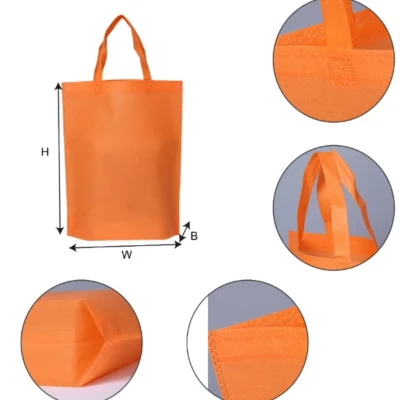
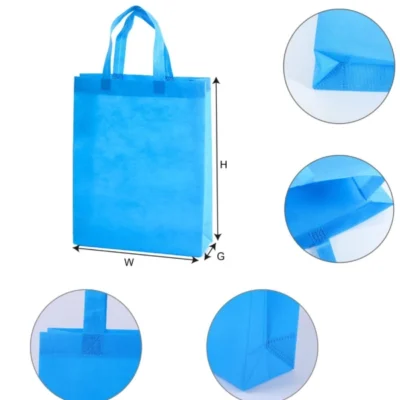
This type of non-woven bag features a boxy structure with both bottom and side gussets, giving it more volume and better shape compared to flat or single-bottom bags. It is widely used in grocery shopping, food delivery, and apparel packaging, making it ideal for carrying larger or bulkier items. These bags are usually produced using ultrasonic heat-sealing3, resulting in neat edges and strong sealing. Compared to stitched bags, this method maintains good load-bearing strength while offering better cost efficiency.
The non-woven tote bag is one of the most classic and widely used designs in the market. It has a structured shape with a bottom and side gussets, providing a large capacity and stable form. Unlike heat-sealed bags, tote bags are typically made with stitched seams for added strength. Featuring long handles that make them easy to carry on the shoulder, these bags are ideal for daily shopping, trade shows, giveaways, and brand promotions. For businesses looking for a reusable, practical, and eco-friendly packaging solution, this style is a top choice.
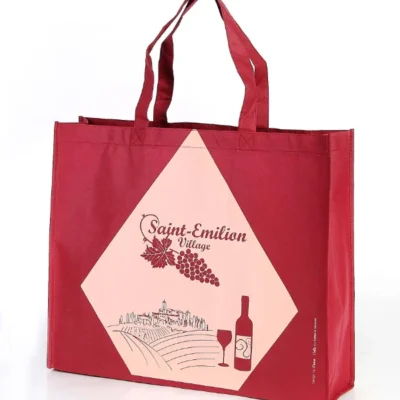

The non-woven bag with reinforced handles is specially designed for greater durability and strength. Unlike standard totes, the handles are extended down along the sides of the bag and stitched in place, creating a loop that distributes weight more evenly. This structure significantly improves the bag’s load-bearing capacity and reduces the risk of tearing under heavy use. It’s a great option for carrying documents, books, promo kits, or other heavier items, especially in commercial and retail settings where strength and reliability are essential.
The drawstring non-woven bag features a simple top-closure design that allows for quick access and secure storage, making it a lightweight and practical option. Some versions include shoulder straps so the bag can be worn like a backpack, while others have no straps and serve as pouch-style carry bags. This highly flexible design is ideal for event giveaways, sports gear, student packs, or daily personal storage. For businesses looking for affordable and easy-to-distribute packaging, this style remains a popular and effective choice.
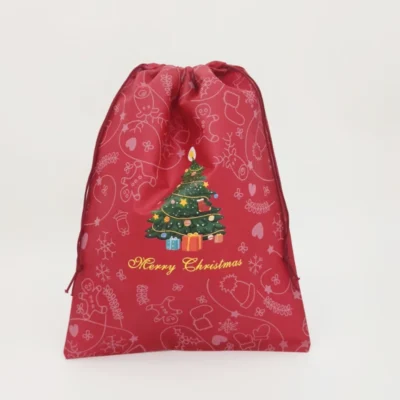
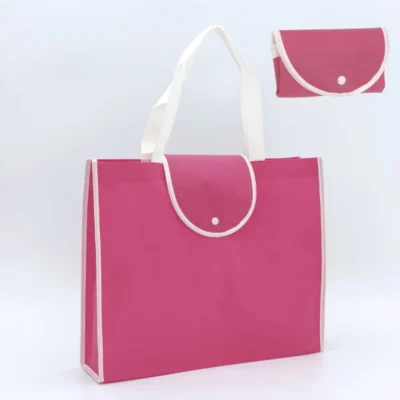
The foldable non-woven bag is designed for portability and everyday convenience. It can be folded into a compact shape when not in use, making it easy to carry as a backup eco bag. These bags are often used for shopping, travel, or on-the-go packing. Some models include built-in pouches or snap buttons to help fold and store the bag neatly. Lightweight, durable, and reusable, they offer an eco-friendly solution while also being a smart tool for everyday life or brand promotions.
Printed non-woven bags refer to any type of non-woven bag that features customized printing—such as company logos, brand names, slogans, or full-color graphics. Almost every style of non-woven bag, including D cut bags, tote bags, laminated bags, and drawstring bags, can be printed to suit specific marketing or retail needs. Common printing methods include screen printing, heat transfer, and flexographic printing, depending on the design complexity and material type. These bags are widely used for branding, promotional giveaways, corporate gift packaging, and retail, helping businesses boost visibility while maintaining an eco-conscious image.

A laminated non-woven bag has a thin film layer—typically BOPP—applied to the surface of the fabric, creating either a glossy or matte finish. This lamination enhances the bag’s durability, water resistance, and overall appearance. It’s especially suitable for packaging that demands a more premium look or added protection, such as food delivery, gift packaging, or high-end retail products.
Heat-sealed non-woven bags are made by fusing materials together using ultrasonic technology, without the need for stitching. This process is highly efficient and ideal for mass production. The finished bags have smooth edges and a clean appearance. Common styles include D cut bags, W cut bags, bottom gusset bags, and box-shaped bags with both sides and bottom. Thanks to their low cost and neat look, heat-sealed bags are widely favored. However, they typically offer less strength than stitched bags, making them better suited for carrying light to medium-weight items.
Stitched non-woven bags are assembled using industrial sewing machines, with reinforced seams that provide strong structure and long-lasting durability. This method greatly improves the bag’s load-bearing capacity and allows it to withstand repeated use, making it suitable for applications that require higher strength and reliability. Popular stitched styles include tote bags, reinforced handle bags, and foldable bags. While this method involves more labor, slightly higher costs, and longer lead times, the final products are much sturdier and can hold heavier items. They also have a more premium appearance compared to heat-sealed bags.
With a wide range of styles and two distinct production methods, non-woven bags offer versatile solutions to meet different functional needs, design preferences, and cost considerations. This guide has provided a detailed breakdown of the major non-woven bag types — from simple D-cut designs to reinforced totes and laminated options — along with the differences between stitched and heat-sealed production methods4. Whether you’re planning for daily retail use, promotional events, or custom branded packaging, understanding these design and manufacturing variations will help you select the most suitable non-woven bag for your business requirements.
If you’re looking for a professional non woven bag manufacturer or want to create custom eco-friendly bags that match your brand, Yanxin Bag offers a complete one-stop solution. From bag structure and materials to logo printing and packaging customization, we’re here to help you create non-woven bags that perfectly fit your needs.
Contact Yanxin Bag today to get free design advice and samples—start building your high-quality, custom non woven packaging solution now!
Need a full picture of non-woven bags from materials to customization?
This guide gives you everything — from bag styles and use cases to printing methods and eco-friendly customization tips.
Curious about whether non-woven bags are actually worth it?
This article explains their main pros and cons, including durability, sustainability, and cost-effectiveness for businesses.
Paper bags or non-woven bags — which is truly the better eco choice?
Here’s a detailed comparison across weight, durability, water resistance, and branding potential to help you decide.
Ever wondered what non-woven fabric actually is?
This complete guide dives into materials like PP, PET, and PLA, explaining how they’re made and what makes each one unique.
Get a free quote and expert consultation today. Let's bring your brand vision to life.
1Learn about polypropylene pellets, their production, and how they contribute to various industries, including eco-friendly products.
2Learn strategies for maximizing your presence at trade shows with effective bag usage for marketing and branding.
3Learn about ultrasonic heat-sealing technology and its benefits in producing strong, durable bags with neat edges.
4Discover the heat-sealing process to appreciate its efficiency and benefits in bag manufacturing.
Answer: Non-woven bags are reusable, recyclable, and have lower toxicity compared to traditional plastic bags. They offer longer service life and can be customized to meet various needs and aesthetics.
Answer: Based on production methods, non-woven bags are classified into heat-sealed bags, produced using ultrasonic bonding, and stitched bags, assembled through industrial sewing processes.
Answer: Non-woven bags are typically made from polypropylene (PP), a type of thermoplastic polymer. The material is processed into fibers and bonded together using heat or chemical methods to form a durable fabric.
Answer: Non-woven bags are widely used for shopping, promotional events, packaging, travel organization, and as eco-friendly alternatives in various industries, including agriculture, construction, and healthcare.
Answer: Non-woven bags can be cleaned by gently wiping with a damp cloth or hand washing with mild soap. Avoid using strong detergents or machine washing, as this can degrade the material.
Answer: Non-woven bags can be customized in terms of size, color, design, and printing. Common printing methods include screen printing, heat transfer, and gravure printing, allowing businesses to add logos, slogans, and other branding elements.
Answer: Non-woven bags with reinforced handles or stitched tote bags are the most reliable for heavy loads. Their reinforced seams and extended handles distribute weight evenly, reducing the risk of tearing.
Answer: Yes, laminated non-woven bags have an extra BOPP film layer, which improves water resistance, durability, and appearance. They are especially suitable for premium packaging and food delivery.
Answer: Yes, foldable non-woven bags are specifically designed to be compact. They can be folded into a pouch or secured with snaps, making them portable and convenient for everyday use.
Answer: Non-woven bags are widely applied in retail, supermarkets, fashion packaging, promotional events, healthcare, and food delivery, offering both practicality and brand promotion opportunities.
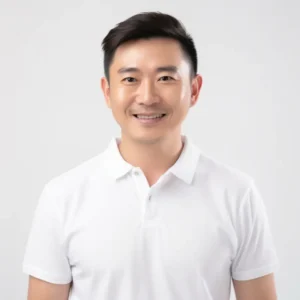
Order or no-order we are Always here to help you!
We will contact you within 1 working day, please pay attention to the email with the suffix “@yanxinbag.com”.
Order or no-order we are Always here to help you!
We will contact you within 1 working day, please pay attention to the email with the suffix “@yanxinbag.com”.